Campaign Report: Assessing Media's Attitude Towards Disability
VerifiedAdded on 2021/05/27
|7
|891
|22
Report
AI Summary
This report examines a campaign focused on assessing and changing the media's attitude towards people with disabilities, particularly in the Australian context. The campaign aims to increase the visibility and representation of disabled individuals in mainstream media, addressing societal stigma and promoting inclusion. The report details the campaign's background, objectives, strategies, and implementation plan, including the use of social media and collaborations with key stakeholders. It analyzes the policy environment, identifies the campaign's credibility-building tactics, and discusses the expected outcomes. The campaign's goal is to normalize disability and challenge existing perceptions, ultimately fostering a more inclusive and equitable society. The report concludes by emphasizing the collective responsibility of organizations like the Attitude Foundation to drive positive change in media representation.
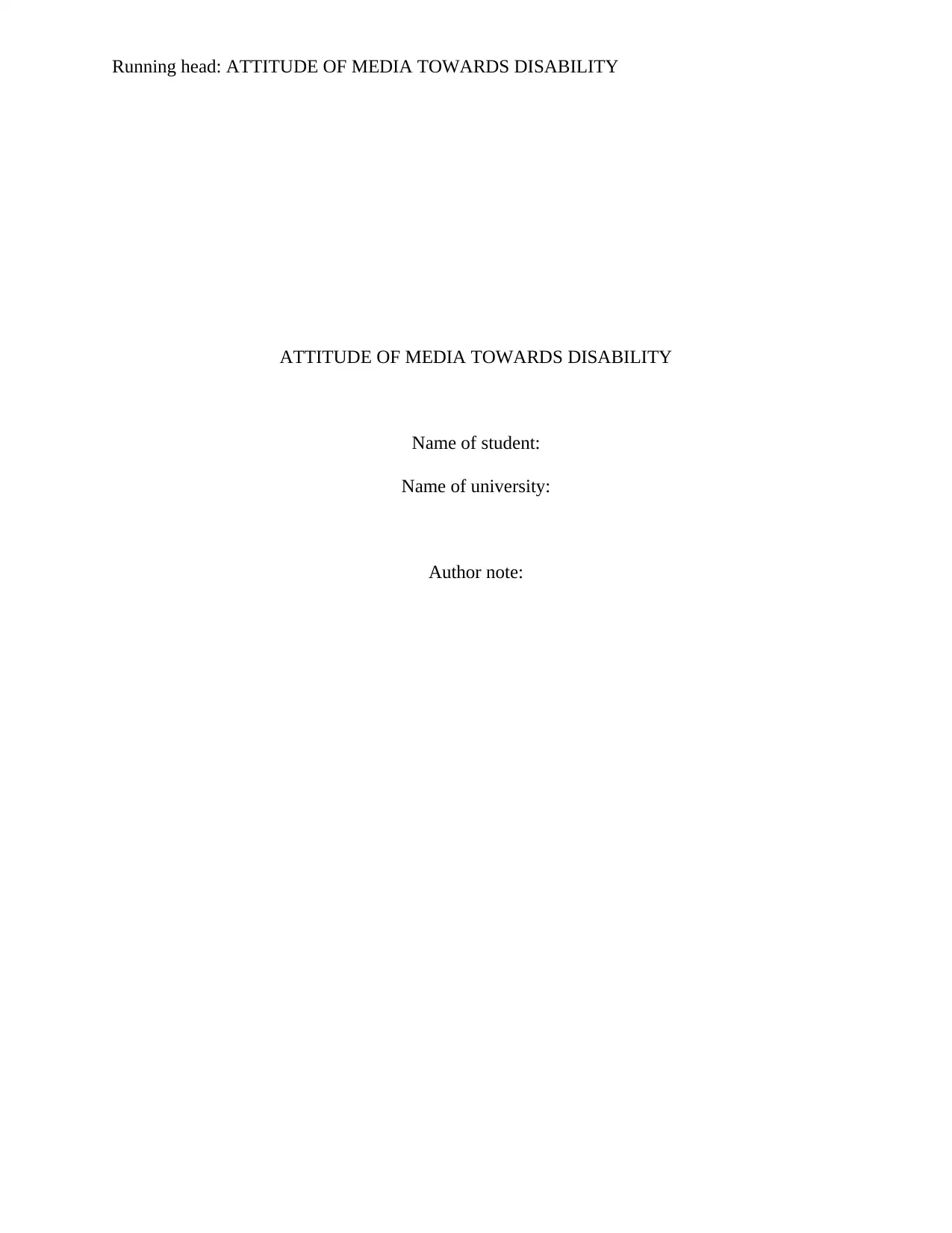
Running head: ATTITUDE OF MEDIA TOWARDS DISABILITY
ATTITUDE OF MEDIA TOWARDS DISABILITY
Name of student:
Name of university:
Author note:
ATTITUDE OF MEDIA TOWARDS DISABILITY
Name of student:
Name of university:
Author note:
Paraphrase This Document
Need a fresh take? Get an instant paraphrase of this document with our AI Paraphraser
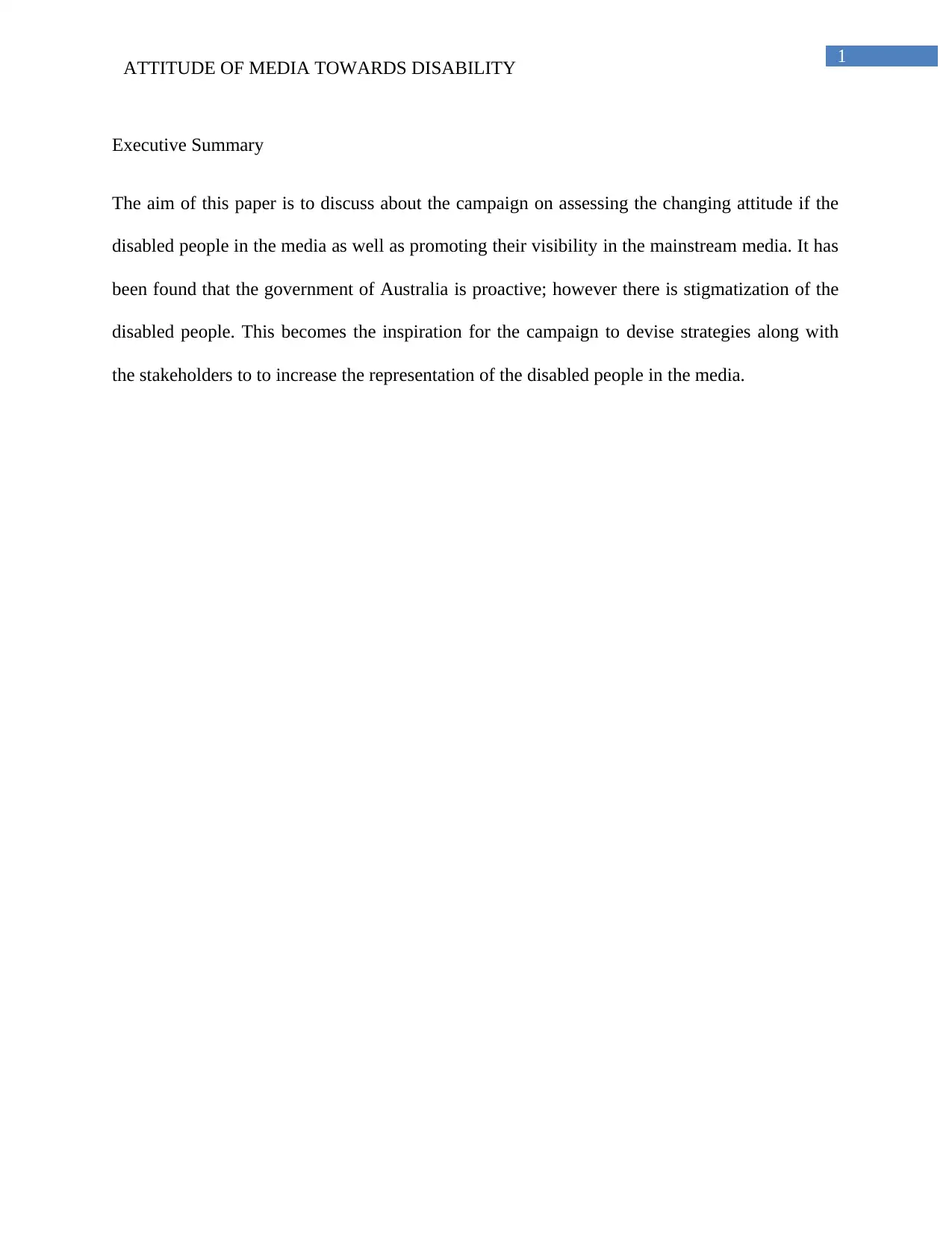
1
ATTITUDE OF MEDIA TOWARDS DISABILITY
Executive Summary
The aim of this paper is to discuss about the campaign on assessing the changing attitude if the
disabled people in the media as well as promoting their visibility in the mainstream media. It has
been found that the government of Australia is proactive; however there is stigmatization of the
disabled people. This becomes the inspiration for the campaign to devise strategies along with
the stakeholders to to increase the representation of the disabled people in the media.
ATTITUDE OF MEDIA TOWARDS DISABILITY
Executive Summary
The aim of this paper is to discuss about the campaign on assessing the changing attitude if the
disabled people in the media as well as promoting their visibility in the mainstream media. It has
been found that the government of Australia is proactive; however there is stigmatization of the
disabled people. This becomes the inspiration for the campaign to devise strategies along with
the stakeholders to to increase the representation of the disabled people in the media.
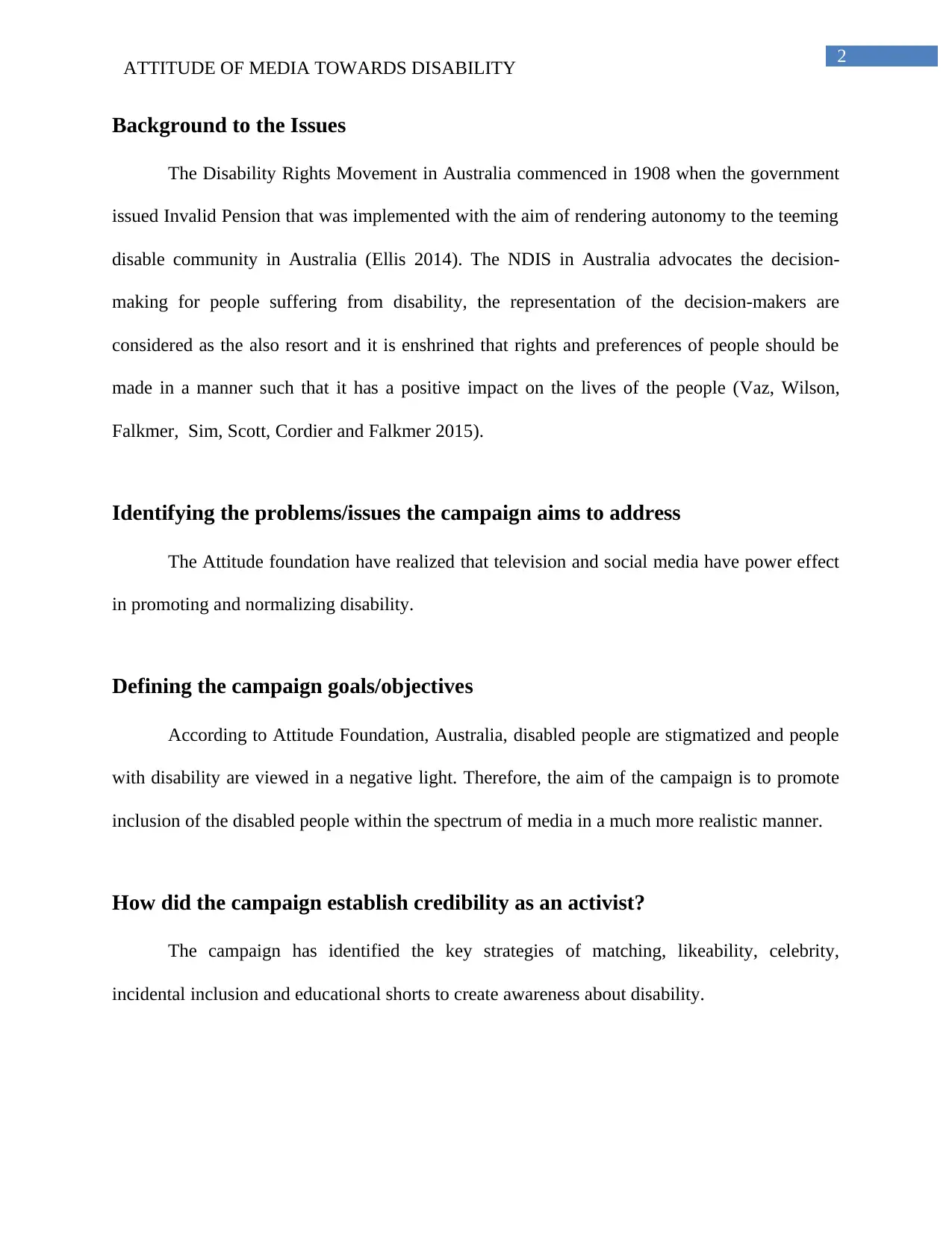
2
ATTITUDE OF MEDIA TOWARDS DISABILITY
Background to the Issues
The Disability Rights Movement in Australia commenced in 1908 when the government
issued Invalid Pension that was implemented with the aim of rendering autonomy to the teeming
disable community in Australia (Ellis 2014). The NDIS in Australia advocates the decision-
making for people suffering from disability, the representation of the decision-makers are
considered as the also resort and it is enshrined that rights and preferences of people should be
made in a manner such that it has a positive impact on the lives of the people (Vaz, Wilson,
Falkmer, Sim, Scott, Cordier and Falkmer 2015).
Identifying the problems/issues the campaign aims to address
The Attitude foundation have realized that television and social media have power effect
in promoting and normalizing disability.
Defining the campaign goals/objectives
According to Attitude Foundation, Australia, disabled people are stigmatized and people
with disability are viewed in a negative light. Therefore, the aim of the campaign is to promote
inclusion of the disabled people within the spectrum of media in a much more realistic manner.
How did the campaign establish credibility as an activist?
The campaign has identified the key strategies of matching, likeability, celebrity,
incidental inclusion and educational shorts to create awareness about disability.
ATTITUDE OF MEDIA TOWARDS DISABILITY
Background to the Issues
The Disability Rights Movement in Australia commenced in 1908 when the government
issued Invalid Pension that was implemented with the aim of rendering autonomy to the teeming
disable community in Australia (Ellis 2014). The NDIS in Australia advocates the decision-
making for people suffering from disability, the representation of the decision-makers are
considered as the also resort and it is enshrined that rights and preferences of people should be
made in a manner such that it has a positive impact on the lives of the people (Vaz, Wilson,
Falkmer, Sim, Scott, Cordier and Falkmer 2015).
Identifying the problems/issues the campaign aims to address
The Attitude foundation have realized that television and social media have power effect
in promoting and normalizing disability.
Defining the campaign goals/objectives
According to Attitude Foundation, Australia, disabled people are stigmatized and people
with disability are viewed in a negative light. Therefore, the aim of the campaign is to promote
inclusion of the disabled people within the spectrum of media in a much more realistic manner.
How did the campaign establish credibility as an activist?
The campaign has identified the key strategies of matching, likeability, celebrity,
incidental inclusion and educational shorts to create awareness about disability.
⊘ This is a preview!⊘
Do you want full access?
Subscribe today to unlock all pages.

Trusted by 1+ million students worldwide
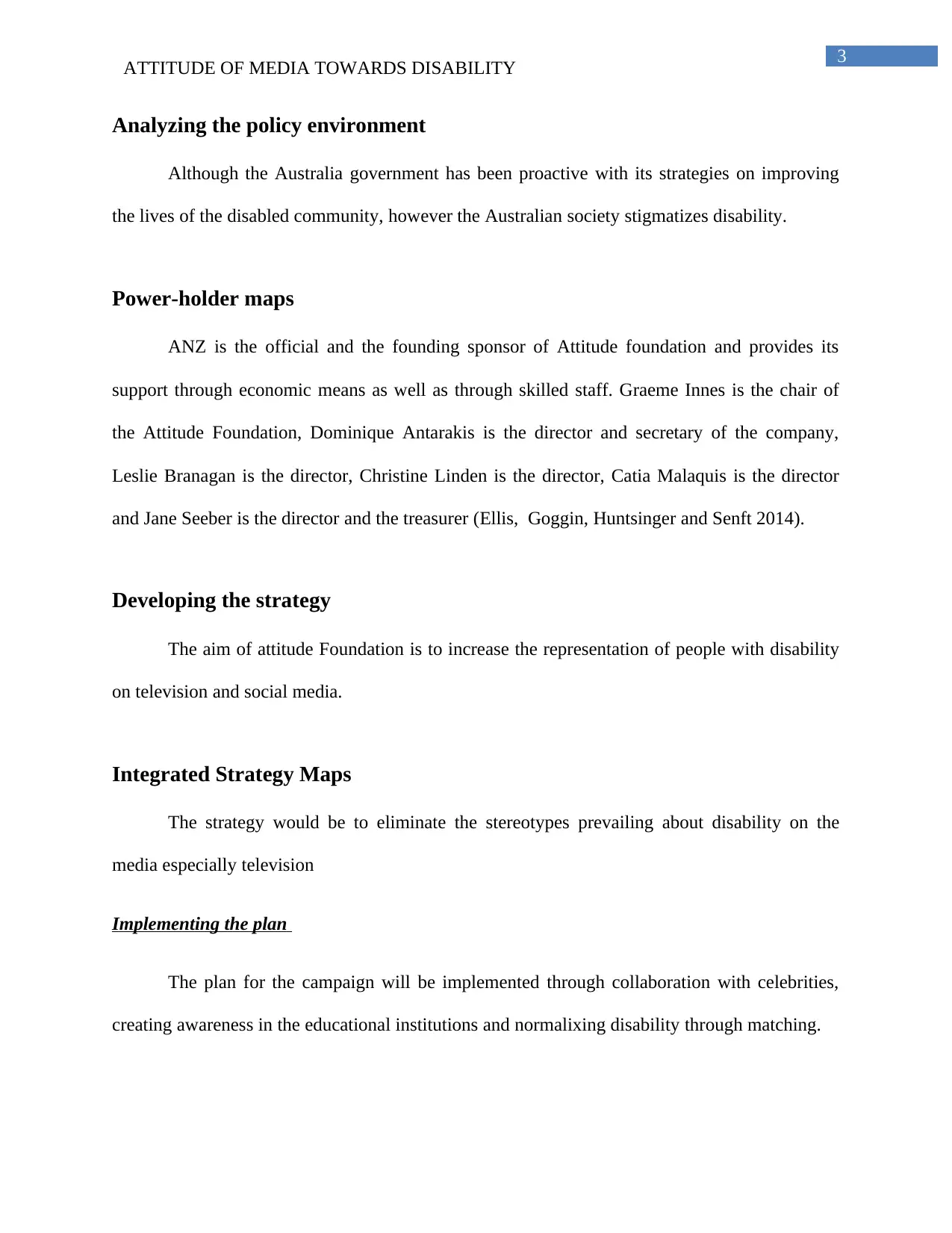
3
ATTITUDE OF MEDIA TOWARDS DISABILITY
Analyzing the policy environment
Although the Australia government has been proactive with its strategies on improving
the lives of the disabled community, however the Australian society stigmatizes disability.
Power-holder maps
ANZ is the official and the founding sponsor of Attitude foundation and provides its
support through economic means as well as through skilled staff. Graeme Innes is the chair of
the Attitude Foundation, Dominique Antarakis is the director and secretary of the company,
Leslie Branagan is the director, Christine Linden is the director, Catia Malaquis is the director
and Jane Seeber is the director and the treasurer (Ellis, Goggin, Huntsinger and Senft 2014).
Developing the strategy
The aim of attitude Foundation is to increase the representation of people with disability
on television and social media.
Integrated Strategy Maps
The strategy would be to eliminate the stereotypes prevailing about disability on the
media especially television
Implementing the plan
The plan for the campaign will be implemented through collaboration with celebrities,
creating awareness in the educational institutions and normalixing disability through matching.
ATTITUDE OF MEDIA TOWARDS DISABILITY
Analyzing the policy environment
Although the Australia government has been proactive with its strategies on improving
the lives of the disabled community, however the Australian society stigmatizes disability.
Power-holder maps
ANZ is the official and the founding sponsor of Attitude foundation and provides its
support through economic means as well as through skilled staff. Graeme Innes is the chair of
the Attitude Foundation, Dominique Antarakis is the director and secretary of the company,
Leslie Branagan is the director, Christine Linden is the director, Catia Malaquis is the director
and Jane Seeber is the director and the treasurer (Ellis, Goggin, Huntsinger and Senft 2014).
Developing the strategy
The aim of attitude Foundation is to increase the representation of people with disability
on television and social media.
Integrated Strategy Maps
The strategy would be to eliminate the stereotypes prevailing about disability on the
media especially television
Implementing the plan
The plan for the campaign will be implemented through collaboration with celebrities,
creating awareness in the educational institutions and normalixing disability through matching.
Paraphrase This Document
Need a fresh take? Get an instant paraphrase of this document with our AI Paraphraser
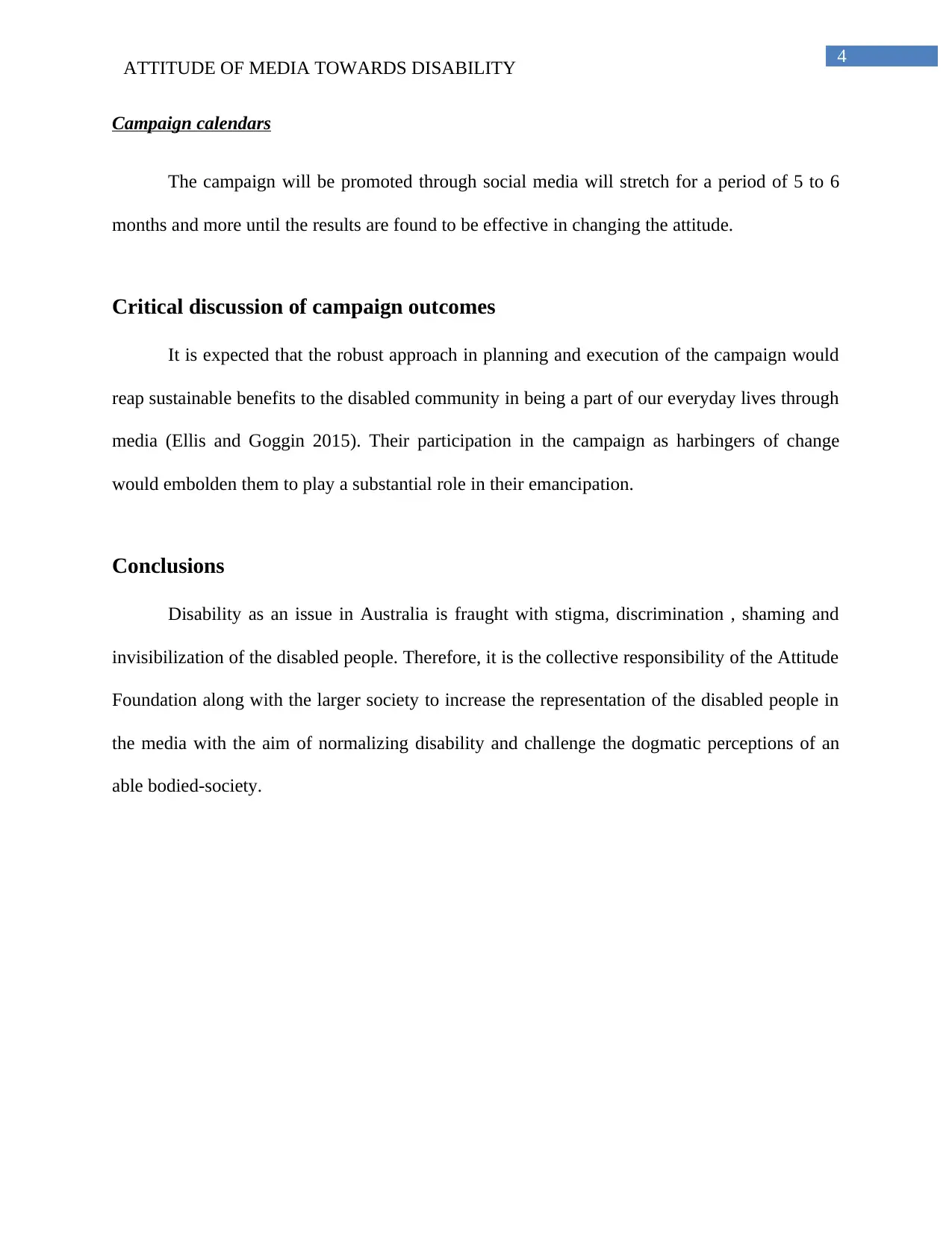
4
ATTITUDE OF MEDIA TOWARDS DISABILITY
Campaign calendars
The campaign will be promoted through social media will stretch for a period of 5 to 6
months and more until the results are found to be effective in changing the attitude.
Critical discussion of campaign outcomes
It is expected that the robust approach in planning and execution of the campaign would
reap sustainable benefits to the disabled community in being a part of our everyday lives through
media (Ellis and Goggin 2015). Their participation in the campaign as harbingers of change
would embolden them to play a substantial role in their emancipation.
Conclusions
Disability as an issue in Australia is fraught with stigma, discrimination , shaming and
invisibilization of the disabled people. Therefore, it is the collective responsibility of the Attitude
Foundation along with the larger society to increase the representation of the disabled people in
the media with the aim of normalizing disability and challenge the dogmatic perceptions of an
able bodied-society.
ATTITUDE OF MEDIA TOWARDS DISABILITY
Campaign calendars
The campaign will be promoted through social media will stretch for a period of 5 to 6
months and more until the results are found to be effective in changing the attitude.
Critical discussion of campaign outcomes
It is expected that the robust approach in planning and execution of the campaign would
reap sustainable benefits to the disabled community in being a part of our everyday lives through
media (Ellis and Goggin 2015). Their participation in the campaign as harbingers of change
would embolden them to play a substantial role in their emancipation.
Conclusions
Disability as an issue in Australia is fraught with stigma, discrimination , shaming and
invisibilization of the disabled people. Therefore, it is the collective responsibility of the Attitude
Foundation along with the larger society to increase the representation of the disabled people in
the media with the aim of normalizing disability and challenge the dogmatic perceptions of an
able bodied-society.
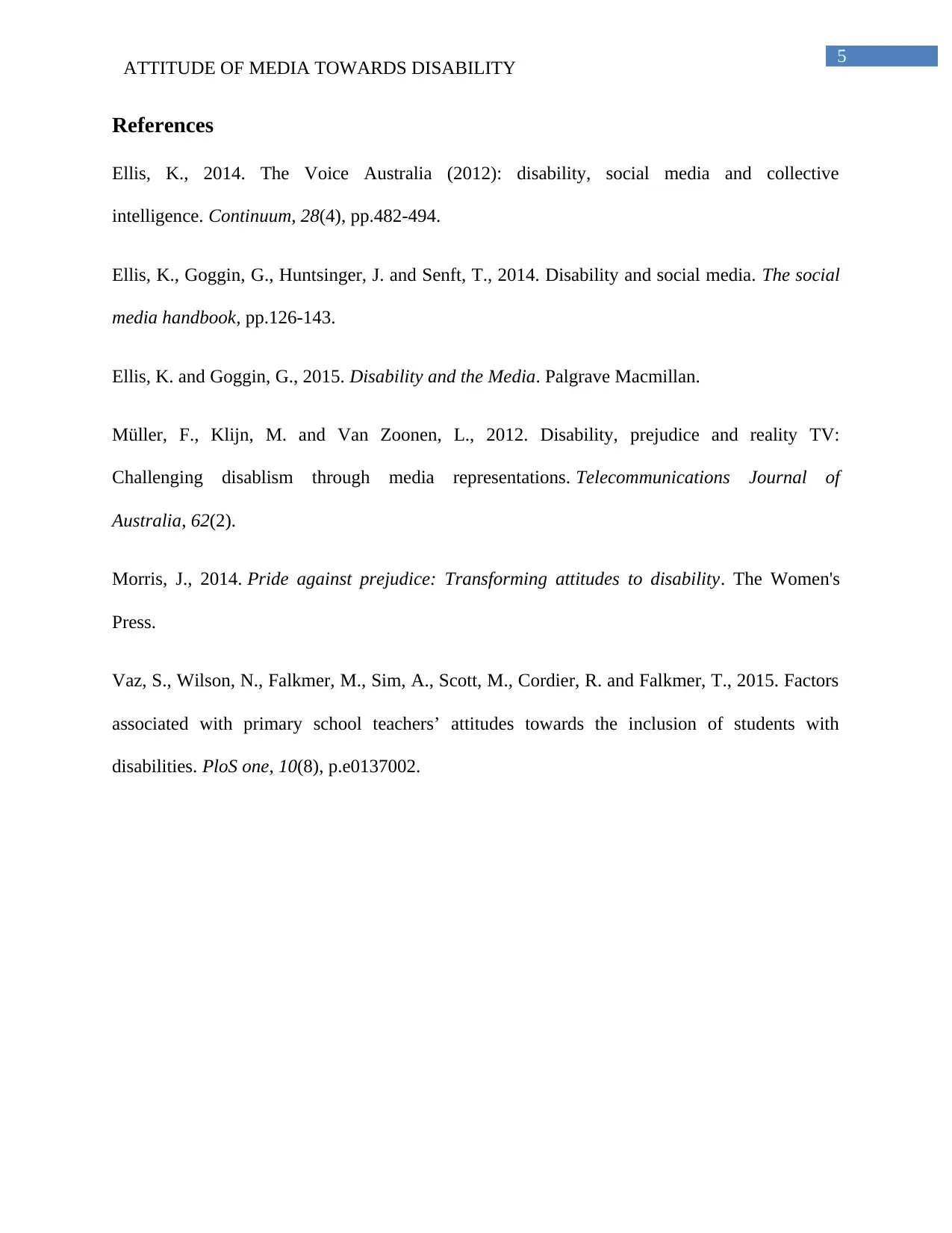
5
ATTITUDE OF MEDIA TOWARDS DISABILITY
References
Ellis, K., 2014. The Voice Australia (2012): disability, social media and collective
intelligence. Continuum, 28(4), pp.482-494.
Ellis, K., Goggin, G., Huntsinger, J. and Senft, T., 2014. Disability and social media. The social
media handbook, pp.126-143.
Ellis, K. and Goggin, G., 2015. Disability and the Media. Palgrave Macmillan.
Müller, F., Klijn, M. and Van Zoonen, L., 2012. Disability, prejudice and reality TV:
Challenging disablism through media representations. Telecommunications Journal of
Australia, 62(2).
Morris, J., 2014. Pride against prejudice: Transforming attitudes to disability. The Women's
Press.
Vaz, S., Wilson, N., Falkmer, M., Sim, A., Scott, M., Cordier, R. and Falkmer, T., 2015. Factors
associated with primary school teachers’ attitudes towards the inclusion of students with
disabilities. PloS one, 10(8), p.e0137002.
ATTITUDE OF MEDIA TOWARDS DISABILITY
References
Ellis, K., 2014. The Voice Australia (2012): disability, social media and collective
intelligence. Continuum, 28(4), pp.482-494.
Ellis, K., Goggin, G., Huntsinger, J. and Senft, T., 2014. Disability and social media. The social
media handbook, pp.126-143.
Ellis, K. and Goggin, G., 2015. Disability and the Media. Palgrave Macmillan.
Müller, F., Klijn, M. and Van Zoonen, L., 2012. Disability, prejudice and reality TV:
Challenging disablism through media representations. Telecommunications Journal of
Australia, 62(2).
Morris, J., 2014. Pride against prejudice: Transforming attitudes to disability. The Women's
Press.
Vaz, S., Wilson, N., Falkmer, M., Sim, A., Scott, M., Cordier, R. and Falkmer, T., 2015. Factors
associated with primary school teachers’ attitudes towards the inclusion of students with
disabilities. PloS one, 10(8), p.e0137002.
⊘ This is a preview!⊘
Do you want full access?
Subscribe today to unlock all pages.

Trusted by 1+ million students worldwide
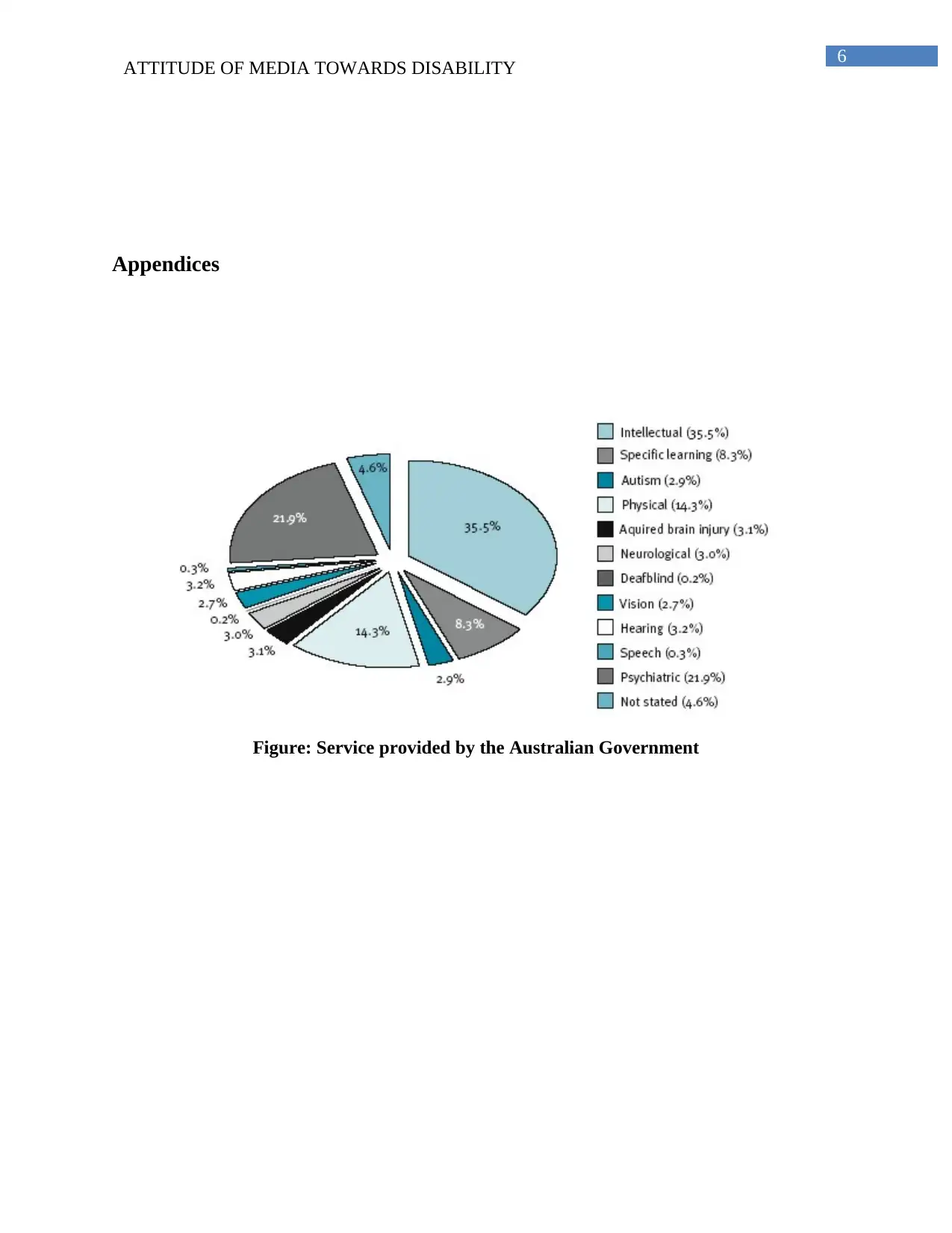
6
ATTITUDE OF MEDIA TOWARDS DISABILITY
Appendices
Figure: Service provided by the Australian Government
ATTITUDE OF MEDIA TOWARDS DISABILITY
Appendices
Figure: Service provided by the Australian Government
1 out of 7
Related Documents
Your All-in-One AI-Powered Toolkit for Academic Success.
+13062052269
info@desklib.com
Available 24*7 on WhatsApp / Email
![[object Object]](/_next/static/media/star-bottom.7253800d.svg)
Unlock your academic potential
Copyright © 2020–2025 A2Z Services. All Rights Reserved. Developed and managed by ZUCOL.




